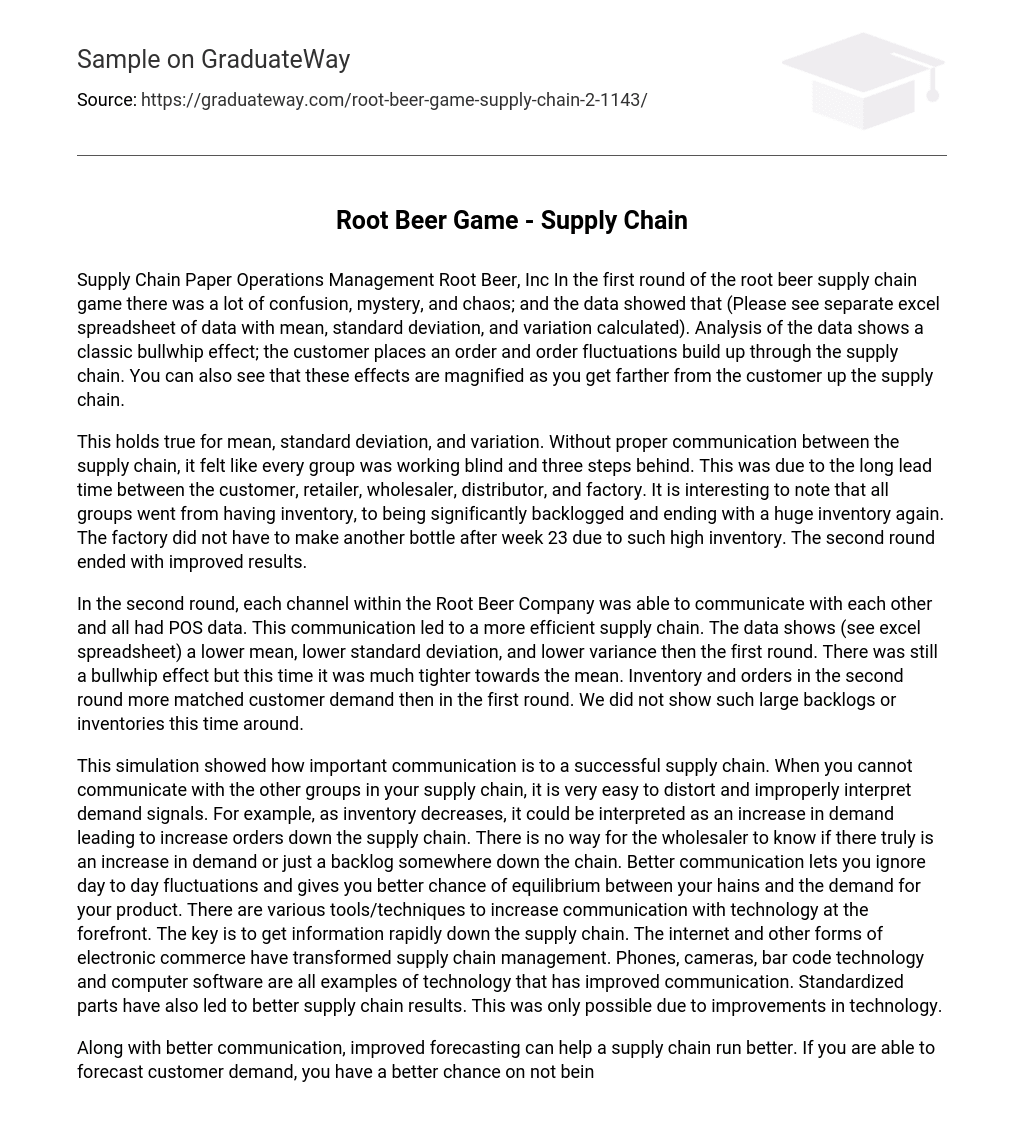Supply Chain Paper Operations Management Root Beer, Inc In the first round of the root beer supply chain game there was a lot of confusion, mystery, and chaos; and the data showed that (Please see separate excel spreadsheet of data with mean, standard deviation, and variation calculated). Analysis of the data shows a classic bullwhip effect; the customer places an order and order fluctuations build up through the supply chain. You can also see that these effects are magnified as you get farther from the customer up the supply chain.
This holds true for mean, standard deviation, and variation. Without proper communication between the supply chain, it felt like every group was working blind and three steps behind. This was due to the long lead time between the customer, retailer, wholesaler, distributor, and factory. It is interesting to note that all groups went from having inventory, to being significantly backlogged and ending with a huge inventory again. The factory did not have to make another bottle after week 23 due to such high inventory. The second round ended with improved results.
In the second round, each channel within the Root Beer Company was able to communicate with each other and all had POS data. This communication led to a more efficient supply chain. The data shows (see excel spreadsheet) a lower mean, lower standard deviation, and lower variance then the first round. There was still a bullwhip effect but this time it was much tighter towards the mean. Inventory and orders in the second round more matched customer demand then in the first round. We did not show such large backlogs or inventories this time around.
This simulation showed how important communication is to a successful supply chain. When you cannot communicate with the other groups in your supply chain, it is very easy to distort and improperly interpret demand signals. For example, as inventory decreases, it could be interpreted as an increase in demand leading to increase orders down the supply chain. There is no way for the wholesaler to know if there truly is an increase in demand or just a backlog somewhere down the chain. Better communication lets you ignore day to day fluctuations and gives you better chance of equilibrium between your hains and the demand for your product. There are various tools/techniques to increase communication with technology at the forefront. The key is to get information rapidly down the supply chain. The internet and other forms of electronic commerce have transformed supply chain management. Phones, cameras, bar code technology and computer software are all examples of technology that has improved communication. Standardized parts have also led to better supply chain results. This was only possible due to improvements in technology.
Along with better communication, improved forecasting can help a supply chain run better. If you are able to forecast customer demand, you have a better chance on not being “tricked” by signals throughout the chain. A company can improve forecasting by looking at their past history, the history within their industry, or simply by asking their customers; predominantly through surveys or focus groups. Another way to improve you supply chain is to see if there is an opportunity to reduce the number of parties or complexity within the supply chain. The more stations there are the better chance for errors and delays.
It is also easier to find and solve issues if your process is less complex. A smaller group also allows for better relationships between partners leading to improved trust. Many companies struggle to improve their supply chain management. Like a game of telephone, there are many different players within a company’s supply chain that communication can get distorted between point A and Z. As we spoke of earlier, technology has improved communication between these players but it does not come without a price. Many companies just can’t afford these technologies or would rather use that money somewhere else.
Another problem is that many times each player within the supply chain has their own goals that may or may not be different than the other players and sometimes the company’s. How a company measures activity weighs heavily on how each group goes about their business. The companies that are able to get each group on the same page and working towards the same goals will be better off. Another reason companies struggle is because they do not have the right people or the right training. For example, many manufacturing companies are seasonal and may not hire people year round.
They may save costs in personnel but it is hard to find someone who is experienced and can become familiar with your company if they only work during the busy season. Finding time to train your company in supply chain management can also be a struggle. There is also a negative spiral effect when a company has to spend so much of their time and resources on damage control, emergency situations, and fixing errors due to an inefficient supply chain and inventory management that they do not have the available resources to improve their supply chain management.
This is a cycle that can be hard to break. Overall, the Root Beer Simulation was a great way to learn about supply chain and inventory management. It showed the important link between communication and a well-run supply chain. It also showed how important inventory management is and how incorrect signals can start a snowball effect of errors and incorrect decisions. I was amazed at the increase in quality of game two over game one just due to sitting with your group during the simulation. It truly showed that communication is key.





